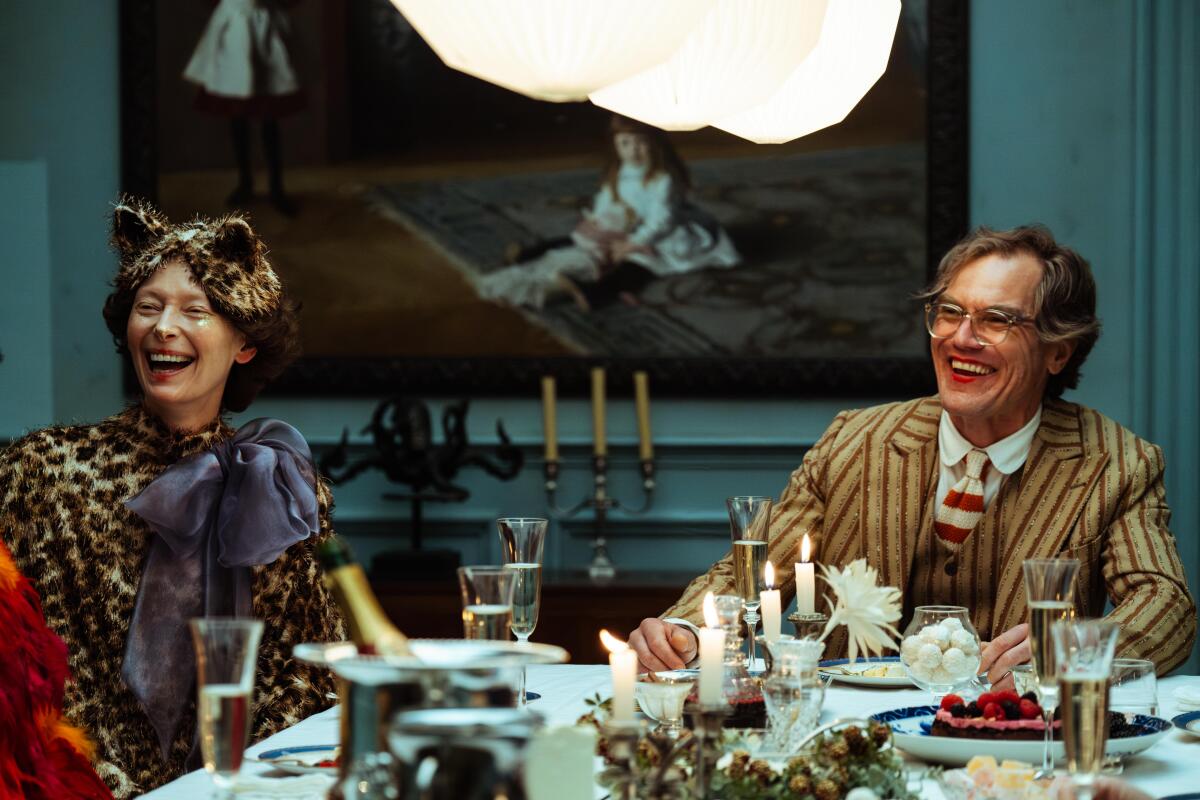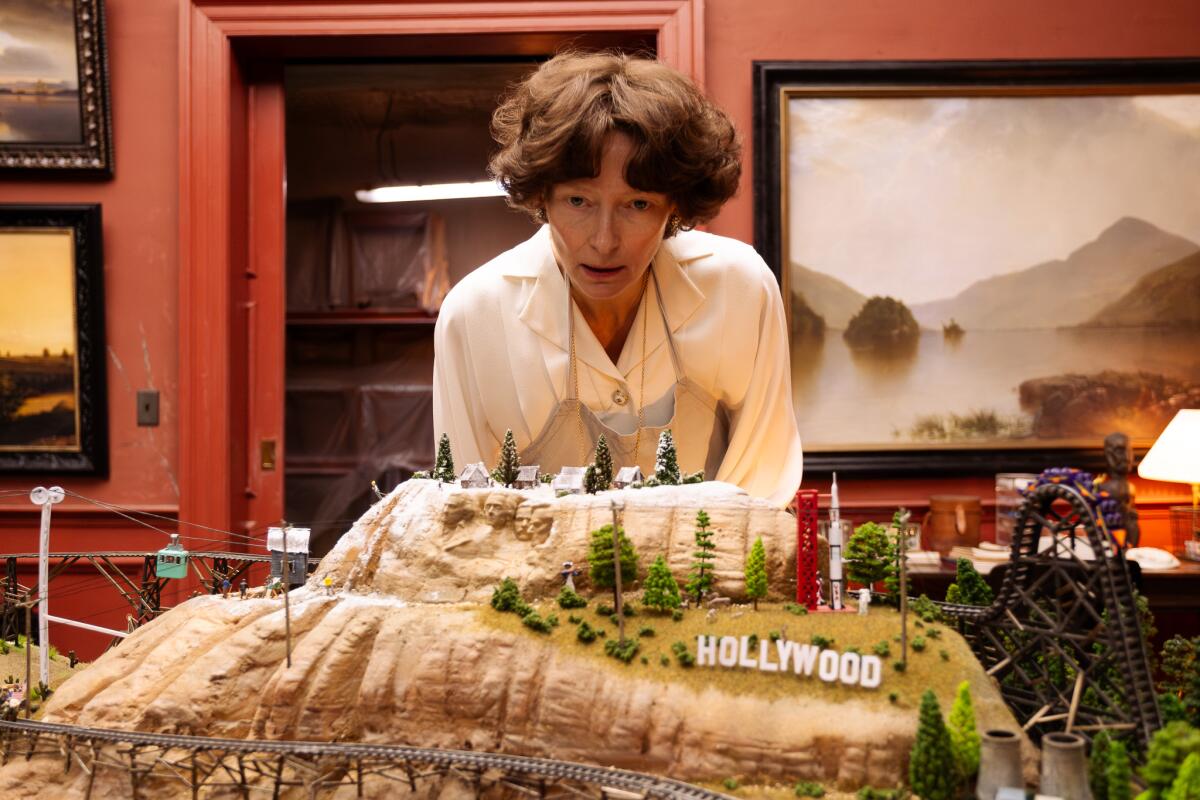Newsletter
Only good movies
Get the Indie Focus newsletter, Mark Olsen's weekly guide to the world of cinema.
You may occasionally receive promotional content from the Los Angeles Times.

It’s a little startling — even if you’re expecting it — when Michael Shannon begins to sing with George MacKay in the opening minutes of “The End.”
“A perfect morning,” MacKay croons, stretching the “o” in “morning” as he puts the final touches on an elaborate diorama of a fantasized all-American landscape: pine trees, a sturdy train track and, for good measure, the Hollywood sign. “No one is stirring / If I were a cat / I’d be purring.” Shannon, bespectacled and business-casual, admires his son’s handiwork and starts his own tune in a sweet falsetto: “To think this all leads to us / It’s quite beautiful even to think about...”
The musical orchestration pillowing their voices is lovely, the singing sincere. No one is winking or making fun, despite the fact that this father and son are extolling the beauty of the morning while inside a sunless bunker six miles underground.
What quickly becomes apparent is that they are lying to themselves and each other — coping, disassociating, self-soothing. And what better way to lie than via a musical?
The other startling thing is that “The End” (in theaters Friday) — a song-driven, postapocalyptic drama that also stars Tilda Swinton, Bronagh Gallagher and Moses Ingram — was conceived and directed by Joshua Oppenheimer, the filmmaker known for his harrowing Oscar-nominated documentaries about the Indonesian genocide of the 1960s, “The Act of Killing” and “The Look of Silence.”
Joshua Oppenheimer, director of the Oscar-nominated documentary ‘The Act of Killing,’ discusses the making and aftermath of the film.
It all sounds a bit like a Mad Libs. Oppenheimer, 50, a deeply thoughtful interviewee, explains that the theme in all his work has been the “gulf between the stories we tell ourselves and the mystery and miracle of what we actually are,” as he says via Zoom from the Catskills during the week of Thanksgiving. “It’s the nothingness and everythingness of the universe waking up and coming to know itself.”
After “The Look of Silence” premiered in 2014, no less a personage than Werner Herzog told Oppenheimer he should do a fiction film next.
“I just said, ‘No,’ flat out,” recalls Oppenheimer, who had begun plotting a new documentary about a family in Japan, wealthy from the oil business and shopping for a luxury survival bunker. After he toured their end-times facility, kitted out with a wine cellar and a swimming pool, his mind was reeling.
“How on earth would this family cope with their guilt for the catastrophe from which they were fleeing?” he wonders. “How would they cope with the remorse for having left loved ones behind? How would they raise a new generation in this place that had never seen the outside world — and therefore be a blank canvas onto which they could paint whatever version of their past they wanted?”
It was in that state that he watched one of his favorite comfort films, the jazzy 1964 French musical “The Umbrellas of Cherbourg,” and suddenly, Oppenheimer had his wild eureka moment.
“One of the great things about making a film [for] which the logline could be ‘Death squad members make a musical to dramatize their memories of genocide,’” he says, referring to his radical, disquieting “The Act of Killing,” “is that it really buys you license to propose any crazy idea and have it taken seriously.”

Oppenheimer, who speaks almost professorially in a gentle, gossamer voice, took his own idea seriously, feeling the theme he wanted to explore dictated a sung approach.
“Maybe the sunny spin that musicals tend to put on a chaotic reality has always drawn me to the form,” he offers, by way of explanation.
The director is well aware that the heyday of American musicals on both stage and screen occurred amid the Great Depression, World War II, the Holocaust and the brink of nuclear obliteration. When the U.S. dropped atomic bombs on Hiroshima and Nagasaki in August 1945, “Carousel” was doing boffo business on Broadway.
“When you walk through a storm, hold your head up high,” the chorus sings in that show’s closing number, “and don’t be afraid of the dark.”
Musicals are, in many cases, delusions, born in times of violence and annihilation. Oppenheimer — such a perfectly apt surname — calls the genre “the wolf of despair in the sheep clothing of hope.”
In 2016, he reached out to Marius de Vries, a British music arranger and producer who has overseen several films including “Moulin Rouge!” and “La La Land.” De Vries was instantly sold: “I was like, ‘You really don’t have to say anything else.’ The idea of combining a postapocalyptic film with a musical is just so bats— crazy and intriguing.”

The first big step was finding the right composer. Oppenheimer engaged Jeanine Tesori, the Tony winner behind “Shrek the Musical” and “Kimberly Akimbo.” Tesori convinced the writer-director that he should pen the lyrics himself — something he had never done before and, he admits, was “a terrifying challenge.”
Tesori had begun setting some of his ideas to music when her mother became sick with cancer, and she decided to drop the project to focus on providing care. She referred Oppenheimer to Joshua Schmidt, a Milwaukee native who has composed music and sound design for live theater in Chicago, New York and London and written seven musicals — including the off-Broadway show “Adding Machine” and two anthology operas.
Schmidt met Oppenheimer via Skype for a preliminary interview. Having read the script, Schmidt suggested this story was really about hope — and then watched the director visibly deflate.
“I thought he was the wrong composer for that reason,” says Oppenheimer. “I said, ‘What do you mean there’s “hope”? Did you misunderstand the story and the ending?’ And he’s like, ‘No, no — I just mean the music is the form of their hope. And it may be a false hope, but it is what gets them out of bed in the morning. And therefore the music needs to have that aspirational, hopeful, soaring quality that builds from little seeds, glimmers of hope.”
Suddenly they were on the same wavelength and Schmidt was hired on March 5, 2020 — a week before the world shut down. “And then I went into the bunker,” Schmidt, 48, quips, recalling the profoundly meta experience that demonstrated to him firsthand how quickly some people go crazy while cooped up inside when the world becomes unlivable outside.
Why wouldn’t people start singing their feelings?
One of the common rules of musical theater is that characters burst into song whenever they need to convey a truth too powerful for spoken language. But here, the songs were motivated by doubt. These elite survivors, who, we learn, were directly responsible for the climate catastrophe and who left family members to die, have been telling themselves stories about their own goodness and courage for more than 20 years. Once those stories start to fray and crumble, though, “The characters are rather like passengers cast from a shipwreck into the sea,” says Oppenheimer, “and they’re desperately reaching for flotsam and jetsam to cobble together a life raft.”
“And those are the songs,” he explains. “They’re reaching for melodies from which to create new anthems of hope — false hope.”

The two Joshuas met via Skype — Oppenheimer from Copenhagen, Schmidt from Milwaukee — nearly every day during the pandemic for seven months, crafting a book of 12 songs in the distinctive rhythm of each character’s speech and inner monologue. “Mother” (Swinton) sings about how the world was once full of strangers, “Father” (Shannon) about the beautiful big blue sky. “Son” (MacKay) attempts to man up about ejecting the “Girl” (Ingram) who appears inside the bunker one day; she is reluctantly allowed to stay, and her first song, a wordless keening, is the first tremor of actual truth.
The lyrics are often empty platitudes — Oppenheimer calls them the equivalent of the politically overused phrase “thoughts and prayers” — and often a character’s train of thought will run out of steam and they’ll reach for a new melody midsong. Fragments get reprised and interwoven; Schmidt constructed the whole thing as a “recursive feedback loop” befitting the sealed setting.
Oppenheimer and Schmidt both wanted actors who could sing, not professional singers — a crucial distinction. These were character songs, and once Swinton came onboard, she argued that this was like a fairy-tale challenge: Whoever agreed to sign up for such a bizarre, audacious assignment was the person who should be cast.
Shannon says he has always loved to sing, participating in a youth chorus in his hometown of Lexington, Ky. He was never a musical theater kid, although he did play upright bass in his high school production of “Bye Bye Birdie.”
“Ever since I was a teenager, this subject has been at the forefront of my mind,” Shannon, 50, says of Oppenheimer’s concept. “I think it’s urgent and important and I liked exploring it in a very different way — you know, as opposed to just banging people over the head with information.”

The cast rehearsed in Ireland for four weeks before shooting. Fiora Cutler, a venerable Hollywood vocal coach, was on hand to make everyone feel safe and supported. Schmidt expected that he might need to alter his sometimes complex, rangy melodies for these untrained singers, and he encouraged them all to find the right voice for their character.
“Tilda loves to sing up in the stratosphere,” Schmidt says. “It’s a strange, beautiful-sounding instrument up there, and that’s where she prefers to sing. Michael sings the lowest note that he can up to the highest note that he can, but he sings it in a voice that is relevant to his characterization of the Father.”
“Still,” he adds, “you’d be surprised how little we had to change.”
The actors’ vocals were performed mostly live, with just a simple piano accompaniment playing in an earpiece. Intricate blocking and choreographed camera movements allowed for long takes with multiple actors overlapping in song.
Forty years later, we catch up with the directors of “The Day After,” “Testament” and “Threads,” films that shocked viewers and changed the minds of politicians.
“When we were rehearsing,” Shannon says, “I just had such a hard time imagining how you spend that long underground and you don’t completely lose your mind. And I think one of the ways they found to do that is through this music. Not that any of them, I believe, are the ideal of mental health, but they hold on. They’re holding on through this music.”
Oppenheimer acknowledges that his film feels all the more timely now that questionable attitudes toward the climate are on the rise. “And he’s surrounded by the world’s richest men,” the director says of the president-elect, “to whom he owes favors. I think we can expect an oligarchy now.”
He continues to smile and speak gently as he says all of this. Oppenheimer has stared the ugliest facets of humanity right in the face, and he knows how close we are to the brink of self-destruction. Still, he argues that “The End” is a cautionary tale and therefore, ultimately, positive.
“It seems to be about the future,” he says, but really it’s “a dark vision of the present, made in the conviction that while it may be too late for the family in the film, it’s not too late for us to embrace genuine hope. And genuine hope, in contrast to false hope, is the belief that if we actually stop and look honestly at our problems, we can actually solve those problems — and there’s still time enough to do so.”
Only good movies
Get the Indie Focus newsletter, Mark Olsen's weekly guide to the world of cinema.
You may occasionally receive promotional content from the Los Angeles Times.